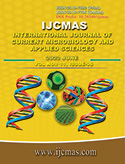


 National Academy of Agricultural Sciences (NAAS)
National Academy of Agricultural Sciences (NAAS)

|
PRINT ISSN : 2319-7692
Online ISSN : 2319-7706 Issues : 12 per year Publisher : Excellent Publishers Email : editorijcmas@gmail.com / submit@ijcmas.com Editor-in-chief: Dr.M.Prakash Index Copernicus ICV 2018: 95.39 NAAS RATING 2020: 5.38 |
Visceral Leishmaniasis is a major health problem of Bihar, India. It is under elimination mode. However, the transmission of the disease is continuing. Some ecological and environmental conditions of the local areas are responsible for the endemicity of the disease. Madhepura district was one of the highly endemic districts for Kala-azar in Bihar. The highly affected blocks Gamharia, Gaihar and Udakishanganj were selected for the study. The cases of Kala-azar declined from 2013 (n=497) to 2020(n=17).The presence of critical sandfly density vector in the locality was also one of the major factors in the transmission of the disease. The Man Hour Density (MHD) of the Kala-azar vector; Phlebotomus argentipes was found 2.5 and 6.2 in insecticide sprayed villages and 1.9 to 9.1 in control village during 2018-20. The bionomics of the established vector P.argentipes was studied in detail with the developmental stages by rearing in the laboratory. The life cycle was completed within one month time at optimal temperature, 26-280 C and humidity, >72%. Sand flies were found scattered in side dwellings in whole areas of endemic regions and confined in dark mud house having cattle sharing the room of human dwelling. All factors responsible for the transmission of the disease like the presence of infected host, ability of vector in the region to pick up parasite, proper development of parasite in the gut of vector and its transmission in fresh host under suitable environmental conditions were present. The findings will be helpful in making the effective control measures to control sandfly density in endemic areas of Kala-azar.
 |
 |
 |
 |
 |